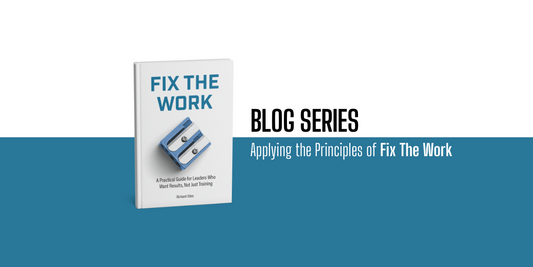Training Feels Like Action. But It’s Just a Guess.
Richard SitesShare This Post
It usually starts with a request. A leader sends an email or makes a comment in a meeting. “We need a training on accountability,” they say. Or maybe it’s communication. Or time management. Or some vague soft skill that’s hard to pin down. Whatever the topic, the urgency feels real, and the assumption is baked in. People are not doing what they should be doing, and the fix must be training.
These requests are not unusual. In fact, they are constant. But if you pause to look at what’s really happening, the problem is rarely about training. It’s about uncertainty. Something in the system is not working the way it should, and no one is quite sure why. So they guess. And when people guess at what’s causing a performance problem, they usually land on one thing: lack of skill.
It’s easy to blame performance gaps on knowledge. It feels logical. If people aren’t performing well, they must not know how. The solution, then, is to teach them. And that’s how the cycle starts. A request goes to the learning team. A module gets built. A webinar gets scheduled. Maybe some coaching sessions are added for good measure.
But here’s the real issue. If no one has taken the time to actually diagnose the problem, the training that gets built is just a dressed-up guess. And it might be a very expensive guess. It might include video production, learning platforms, and polished job aids. But none of that matters if the root cause was never clearly identified. The company ends up investing in a solution without confirming what the problem really is.
This is why training is often the wrong response. Not because training is bad, but because it is used too often as a shortcut for understanding. People feel pressure to do something, to respond, to show they are taking action. And training is a visible, trackable action. You can measure attendance. You can distribute materials. You can point to it in a leadership meeting and say, “We did something.” But the presence of training does not mean a problem has been solved.
When performance breaks down in the workplace, the real work begins with diagnosis. That’s the part that gets skipped the most. It’s not glamorous. It’s not fast. It involves asking uncomfortable questions. Is the issue really a lack of skill? Or is it a lack of clarity? Are expectations being communicated clearly? Are people being managed in a way that supports the desired behavior? Are there tools missing? Are people overloaded?
I remember a project early in my career where the request came in for a training on documentation practices. The assumption was that employees were not documenting correctly because they didn’t know how. But when I went to observe the process in action, the reality was completely different. The team knew exactly what was expected. The problem was that the documentation process was so tedious and poorly integrated with their workflow that they avoided it whenever they could. The fix wasn’t training. The fix was simplifying the system.
This kind of situation is more common than people want to admit. When you start asking better questions, you begin to see how many issues are not actually about knowing what to do. They are about barriers that prevent people from doing it. Those barriers might be systems, unclear feedback, poor management, or even misaligned incentives. And none of those can be solved through training alone.
When you stop guessing, you can start being specific. The tighter your definition of the performance problem, the leaner and more effective your solution can be. You don’t need a course for what could be solved with a checklist. You don’t need a series of videos when the real solution is clearer role expectations. You don’t need to train everyone if only a small group is struggling.
Instructional designers are often viewed as builders of content. But the more powerful role they can play is that of a performance detective. Instead of jumping into production, they can ask questions that slow the rush to build. They can help the business pause and reconsider what it’s really trying to change. They can surface the assumptions baked into requests and help clarify the true nature of the gap.
This requires a shift in mindset. From content creation to problem investigation. From serving every request to challenging the premise behind it. From measuring training activity to measuring behavior change.
If you’re in a learning role, your most valuable contribution might not be the thing you build. It might be the conversation you start. The one that asks, “What’s really happening here?” and stays with that question long enough to uncover something useful.
Until we stop guessing, we’ll keep building solutions that feel right but miss the mark. We’ll keep investing in programs that look good but fail to deliver results. And we’ll keep wondering why performance doesn’t change, even though training is everywhere.
You don’t have a training problem. You have a performance guessing problem. And the good news is, you can fix that. But only if you’re willing to stop building long enough to find out what’s really broken.




